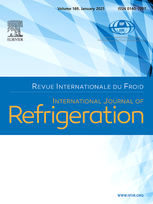
Summary
High pressure miniature air compressor plays an irreplaceable role in some areas such as refrigeration and pneumatic ejection in the fighter. But, as a lot of heat is produced during compression, the cooling system consumes relatively more energy and its volume and weight even exceeds the compressor itself. So, how to design cooling system becomes the key factor. A novel self-air-cooling reciprocating compressor (SACRC) is first proposed in this paper, which can continuously cool the compressor through ingenious structural design without any auxiliary equipment. The SACRC's model is established considering of thermal dynamics and heat exchange characteristics of all the units, which regards the spiral groove in the cooling system as a chamber with compressibility and heat exchange. The characteristics of SACRC are studied by comparative simulation and experiment validation with traditional reciprocating compressor (TRC). The research results showed that the volumetric efficiency and temperature characteristics of SACRC are both improved significantly especially at high output pressure and long working time, which is pioneering significance to further improve the miniaturization of high pressure compressor.
Available documents
Format PDF
Pages: 62-70
Available
Public price
20 €
Member price*
Free
* Best rate depending on membership category (see the detailed benefits of individual and corporate memberships).
Details
- Original title: Design, modeling and characteristics research of a novel self-air-cooling reciprocating compressor.
- Record ID : 30028517
- Languages: English
- Subject: Technology
- Source: International Journal of Refrigeration - Revue Internationale du Froid - vol. 128
- Publication date: 2021/08
- DOI: http://dx.doi.org/10.1016/j.ijrefrig.2021.03.007
- Document available for consultation in the library of the IIR headquarters only.
Links
See other articles in this issue (27)
See the source
Indexing
-
Themes:
Compressors;
Thermodynamic measurements - Keywords: Modelling; Reciprocating compressor; Thermodynamic property; Design; Simulation; Expérimentation; Air; Cooling
-
Analysis on influence factors of back pressure ...
- Author(s) : WANG C., ZHANG S., LEI B., CHENG J., WU J.
- Date : 2022/06
- Languages : English
- Source: International Journal of Refrigeration - Revue Internationale du Froid - vol. 138
- Formats : PDF
View record
-
Thermodynamic model for reciprocating compresso...
- Author(s) : ROSKOSCH D., VENZIK V., ATAKAN B.
- Date : 2017/12
- Languages : English
- Source: International Journal of Refrigeration - Revue Internationale du Froid - vol. 84
- Formats : PDF
View record
-
Geometric model and pressurization analysis on ...
- Author(s) : WANG J., LIU Y., TAN Z., TAN Q.
- Date : 2021/09
- Languages : English
- Source: International Journal of Refrigeration - Revue Internationale du Froid - vol. 129
- Formats : PDF
View record
-
Dynamic analysis of a flexible shaft in a scrol...
- Author(s) : KIM K., HONG G., JANG G
- Date : 2021/07
- Languages : English
- Source: International Journal of Refrigeration - Revue Internationale du Froid - vol. 127
- Formats : PDF
View record
-
Investigating fatigue failure of core motion me...
- Author(s) : WANG S., SUN J., CAO F.
- Date : 2020/09
- Languages : English
- Source: International Journal of Refrigeration - Revue Internationale du Froid - vol. 117
- Formats : PDF
View record
